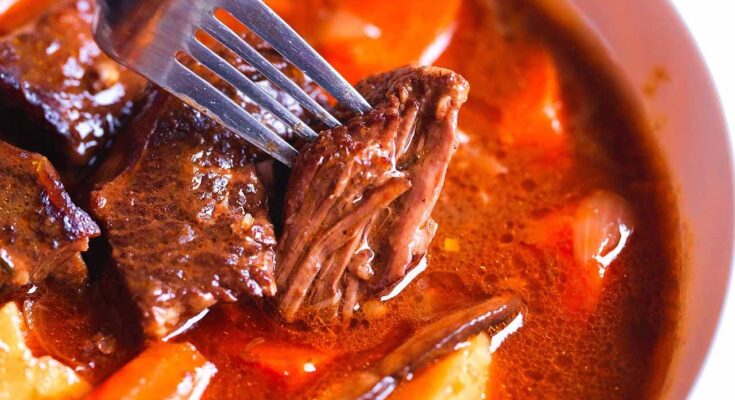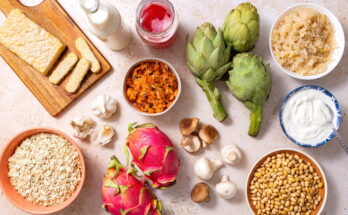Meat Stew Recipe: There’s something inherently comforting about a hot bowl of meat stew. It’s hearty, rich, and packed with flavor that seems to hug your soul. Whether you’re sitting down to dinner after a long day or warming up on a chilly afternoon, stew brings warmth to your kitchen and your heart. But what exactly makes it so beloved across cultures? It’s the simplicity combined with depth—chunks of meat slow-cooked with vegetables and herbs in a savory broth that becomes richer with every simmer.
Stew isn’t just a meal—it’s a tradition. Many of us have fond memories of our grandmothers or parents preparing a bubbling pot of stew that filled the house with mouthwatering aromas. It’s comfort food at its finest. And let’s not forget how incredibly versatile it is—you can use different types of meat, vegetables, and seasonings based on your taste or what you have in your pantry.
Variations Around the World
Meat stew exists in countless forms across the globe. In France, you’ve got Boeuf Bourguignon, where beef is braised with red wine and aromatics. Over in Hungary, they have Gulyás (Goulash)—a paprika-heavy beef stew. Irish Stew often uses lamb or mutton with potatoes and carrots. Then there’s the Moroccan Tagine, a stew made with spices like cumin and cinnamon. Every culture has added its own spin to meat stew, making it a truly universal dish.
What’s great is that no matter where you are, stew reflects the local ingredients and traditions. That means it’s a recipe you can constantly adapt and reinvent while keeping that comforting essence intact.
Ingredients Needed
Essential Ingredients
You can’t make a great meat stew without the right ingredients. While recipes vary, most classic meat stews revolve around these foundational components:
- Meat (Beef, Lamb, Pork, etc.): The star of the show. Choose tougher cuts like chuck roast or shank that benefit from slow cooking.
- Onions and Garlic: These aromatics build your flavor base.
- Carrots and Celery: Add body, sweetness, and nutrition.
- Potatoes: Provide heartiness and help thicken the stew naturally.
- Tomato Paste or Diced Tomatoes: Offer depth and umami.
- Beef Broth or Stock: The liquid gold that ties it all together.
- Bay Leaves, Thyme, and Parsley: Classic herbs that enhance flavor.
- Salt and Pepper: Always essential for seasoning.
- Oil or Butter: For browning the meat and sautéing vegetables.
These are the building blocks, but the beauty of stew lies in its flexibility. You can tweak the ingredients based on your preferences or availability.
Optional Add-ins for Flavor
Want to elevate your stew from basic to restaurant-quality? Try these optional ingredients:
- Red Wine or Beer: For richness and complexity.
- Mushrooms: Add umami and earthy notes.
- Peas or Corn: Toss in at the end for texture and color.
- Worcestershire Sauce or Soy Sauce: Small additions that pack a punch.
- Parsnips or Turnips: For a slightly sweet, rustic twist.
Feel free to experiment—just keep the balance between meat, veggies, and broth.
Choosing the Right Meat
Best Cuts of Meat for Stew
When it comes to stew, the meat you choose can make or break the dish. You might think tender cuts like sirloin are best, but actually, tougher cuts are the real MVPs here. Why? Because they contain more connective tissue and fat, which break down during slow cooking and make the meat melt-in-your-mouth tender.
Here are some top choices:
- Beef Chuck Roast: Arguably the best cut for beef stew—affordable and full of flavor.
- Brisket: A bit pricier but delivers a rich, beefy taste.
- Oxtail or Short Ribs: Great for a gelatin-rich broth.
- Lamb Shoulder or Neck: Perfect for a hearty lamb stew.
- Pork Shoulder (Boston Butt): Works beautifully for pork-based stews.
Don’t be afraid to ask your butcher for stew-friendly cuts—they often know the best bang-for-your-buck options.
Why Tougher Cuts Work Better
Unlike steaks that are meant for quick searing, stew meat needs time. Tougher cuts come with lots of collagen, a connective tissue that, when cooked low and slow, transforms into gelatin. This not only tenderizes the meat but also thickens your stew and gives it that luxurious mouthfeel.
Think of it like this: tender cuts are like sprinters—they’re great in short bursts. Tough cuts are marathon runners—they shine with time and patience.
Prepping the Ingredients
Chopping Vegetables Efficiently
Prepping is often the most time-consuming part of cooking stew, but it’s worth doing right. Uniformity is key here. When chopping carrots, celery, and potatoes, aim for similarly sized pieces so they cook evenly. Nothing’s worse than biting into a stew and finding a half-raw carrot or mushy potato.
Peel and dice onions finely for a smooth base. Mince garlic for even distribution of flavor. For herbs, use fresh when possible and chop them finely to release the oils.
Here’s a quick tip: prep everything before you start cooking. That way, you’re not scrambling while your meat is burning in the pan.
Marinating and Seasoning Meat
While not mandatory, marinating your meat for a few hours—or even overnight—can drastically improve the flavor. A simple mix of olive oil, garlic, herbs, and a splash of vinegar or wine can make a world of difference.
Before browning, season your meat generously with salt and pepper. Some cooks also dust the meat lightly with flour. This not only adds a bit of crust during searing but also helps thicken the stew later on.
Remember, seasoning in layers is key—don’t rely on one big salt dump at the end.
Step-by-Step Cooking Process
Browning the Meat for Flavor
This is the step that separates average stews from amazing ones. Browning (a.k.a. searing) your meat isn’t just for looks—it’s for taste. When you sear meat, you create a Maillard reaction. That’s a fancy term for the browning process that develops deep, savory flavors.
Do it in batches. Overcrowding the pan causes the meat to steam instead of sear. Use high heat and let the meat sit without flipping too soon. You want that beautiful brown crust.
Once done, don’t discard those brown bits on the bottom of the pan. They’re flavor gold.
Layering Ingredients in the Pot
Once your meat is beautifully browned, it’s time to build the stew’s base. Start by removing the meat and setting it aside. In the same pot, add a bit more oil if needed and toss in your aromatics—onions, garlic, maybe some shallots. Let them sweat and release their fragrance. This step develops the flavor base of your stew.
Next, add your firm vegetables like carrots and celery. These need more time to cook, so it makes sense to put them in before the soft ones. Stir them around until they start to soften just a little.
Now’s a great time to add tomato paste or diced tomatoes, which contribute acidity and depth. Let the tomato paste cook for a minute or two to caramelize slightly—it makes a big difference in taste.
Finally, return the browned meat to the pot, pour in your beef broth or stock, and add herbs like thyme and bay leaves. Bring everything to a simmer before reducing the heat and covering the pot.
Simmering for Perfect Texture
The magic of stew happens during the simmer. This isn’t a fast dish—it’s a slow labor of love. Simmering allows flavors to meld, the meat to tenderize, and the broth to become rich and hearty.
Simmer low and slow. You want small bubbles occasionally breaking the surface—not a rolling boil. Too much heat and your meat will get tough. Too little, and you’ll be waiting all day for the vegetables to cook.
Timing depends on your meat, but generally, 1.5 to 3 hours is the sweet spot. Stir occasionally and check the liquid level. If it’s getting too thick or dry, add a bit of water or broth. Taste along the way and adjust seasoning as needed.
Toward the end, toss in any delicate veggies like peas or green beans that don’t need much cooking. This keeps them vibrant and not mushy.
Tips for a Richer Flavor
Deglazing the Pan
Remember those crusty brown bits left after searing the meat? Don’t let them go to waste! Deglazing lifts those bits and turns them into flavor. After sautéing your aromatics, pour in a splash of red wine, beer, or even broth. Use a wooden spoon to scrape the bottom of the pot as the liquid simmers.
This adds complexity and depth to your stew. The alcohol (if used) cooks off, leaving behind richness. Even a tablespoon of balsamic vinegar or Worcestershire sauce at this stage can enhance the umami.
Deglazing is one of those little tricks that makes people wonder what your secret ingredient is. It’s subtle, but powerful.
Herbs, Spices, and Secret Ingredients
A good stew doesn’t just rely on salt and pepper. Layered seasoning is what elevates a dish from “pretty good” to “phenomenal.”
Try fresh herbs like rosemary, parsley, thyme, or oregano. Toss them in at the beginning for infusion, or sprinkle fresh ones on top before serving for a burst of color and taste.
Want a twist? Add a cinnamon stick or star anise for an exotic aroma. A teaspoon of paprika or chili flakes can provide heat. Even a spoon of cocoa powder or a square of dark chocolate gives beef stew a deeper base note—don’t knock it until you try it!
Don’t forget a squeeze of lemon juice or a splash of vinegar at the end. A bit of acidity brightens the flavors and balances the richness.
Adjusting Consistency and Texture
Thickeners: Flour vs. Cornstarch
If your stew ends up too thin, don’t worry—you’ve got options. Many cooks start by tossing their meat in flour before searing. This not only helps with browning but also thickens the stew as it simmers.
Alternatively, you can make a slurry with cornstarch and water. Stir it in toward the end of cooking and let it simmer for a few minutes to activate. It’s a great gluten-free option and works fast.
For a more rustic approach, mash a few cooked potatoes or blend a ladleful of the stew and return it to the pot. This keeps everything natural and adds body.
Balancing Broth and Ingredients
A great stew has a thick, luscious broth—not watery, but not so thick it feels like gravy. The ratio of liquid to solids matters. Start with enough broth to cover your meat and veggies, and reduce if needed as you go.
As it simmers, the broth will reduce and concentrate. Stir occasionally, and check for seasoning. If it tastes flat, add salt. If it’s too salty, a splash of cream or more vegetables can balance it out.
It’s all about finding that perfect mouthfeel—where every spoonful is a little journey of texture and flavor.
Cooking Methods
Stovetop Stew
The classic method. It gives you full control over the heat and lets you adjust as needed. A heavy-bottomed pot or Dutch oven is ideal for even cooking. You’ll need to be around to stir occasionally and monitor the liquid level.
It’s the most interactive way to cook stew—and honestly, the most rewarding if you have the time.
Slow Cooker Variation
Busy day ahead? Toss everything into your slow cooker, set it to low, and let it work its magic for 6 to 8 hours. The meat becomes fall-apart tender, and the hands-off approach is perfect for busy families or workdays.
Just remember to sear your meat and sauté aromatics beforehand if you want maximum flavor. Yes, it’s an extra step, but totally worth it.
Instant Pot or Pressure Cooker
Need stew in under an hour? Pressure cooking is your friend. You still get that rich, slow-cooked taste in a fraction of the time. Most recipes take about 30 to 45 minutes at pressure, with a 10-15 minute natural release.
It’s especially great for weeknights or last-minute cravings.
Serving Suggestions
What to Serve with Meat Stew
A stew this rich deserves equally delicious sides. While meat stew is satisfying on its own, pairing it with the right accompaniments can elevate the whole experience.
- Crusty Bread: Nothing beats dipping a warm slice of bread into a bowl of thick stew. Go for a rustic sourdough, baguette, or even garlic bread.
- Mashed Potatoes: Serve the stew over a mound of creamy mashed potatoes for a classic comfort combo.
- Rice or Quinoa: These grains soak up the juices perfectly, making every bite more satisfying.
- Buttered Noodles: A European-style option that adds texture and heartiness.
- Polenta or Grits: A smooth and slightly sweet base for a rich, savory stew.
Vegetables also make great sides—try a fresh green salad, sautéed green beans, or roasted Brussels sprouts for balance.
Presentation Tips
They say we eat with our eyes first. Even a humble stew can look gourmet with a few simple tricks:
- Use a white bowl or plate to make the colors pop.
- Garnish with fresh herbs like parsley, thyme, or even a dollop of sour cream.
- Serve with a swirl of cream or a drizzle of olive oil for a restaurant-style finish.
- Add colorful veggies like peas or red peppers for visual contrast.
Small touches like these can turn your home-cooked meal into something that feels truly special.
Storage and Reheating
Refrigeration and Freezing Tips
One of the best things about meat stew is how well it keeps. In fact, it often tastes better the next day after the flavors have had time to meld.
- Refrigeration: Store in an airtight container for up to 4–5 days. Let it cool completely before sealing to avoid condensation and spoilage.
- Freezing: Divide into portions and freeze in freezer-safe containers or resealable bags. Stew can last 2–3 months in the freezer without losing much quality.
Label your containers with the date and type for easy access later.
Best Practices for Reheating
When reheating stew, avoid the microwave if possible, as it can make the meat rubbery and unevenly heated.
- Stovetop: The best method. Add a splash of broth or water to rehydrate and warm over medium-low heat, stirring occasionally.
- Microwave: If you must, use a microwave-safe dish, cover loosely, and stir every minute or so for even heating.
Never reheat stew more than once. Only reheat what you plan to eat to maintain food safety and flavor integrity.
Common Mistakes to Avoid
Overcooking or Undercooking
It’s easy to think stew is foolproof, but timing still matters. Overcooking can turn vegetables into mush and make the meat stringy. Undercooking leaves meat tough and unpleasant to chew.
Solution? Simmer low and slow. Test your meat with a fork—if it’s tender and breaks apart easily, it’s done. Don’t rush the process, especially when using tougher cuts.
Skipping the Browning Step
We’ve said it before, and we’ll say it again: Browning is crucial. It’s where the deep, caramelized flavor comes from. Skipping this step results in a flat, one-dimensional stew.
Even if you’re using a slow cooker or Instant Pot, take those extra 10 minutes to sear the meat and sauté your aromatics. It’s the difference between “just okay” and “wow!”
Also, resist the urge to overcrowd your pot when searing. Do it in batches to ensure even browning.
Health Benefits of Meat Stew
Nutritional Value Breakdown
Believe it or not, meat stew can be incredibly nutritious. You get a balance of protein, fiber, and essential nutrients all in one bowl.
- Protein: From the meat—great for muscle repair and energy.
- Fiber: From vegetables like carrots, potatoes, and celery.
- Vitamins & Minerals: Iron, zinc, Vitamin A, and potassium are commonly found.
- Low in Sugar: Most homemade stews contain no added sugars.
- Hydration: The broth provides fluids, especially helpful during colder months.
How to Make it Healthier
- Trim visible fat from your meat before cooking.
- Use low-sodium broth or make your own to control salt levels.
- Add more vegetables like spinach, kale, or bell peppers for added fiber and vitamins.
- Skip the flour or use gluten-free thickeners for a lower-carb version.
Homemade stew is far healthier than store-bought or canned versions, which are often loaded with preservatives and sodium.
Customizing for Dietary Needs
Gluten-Free Options
Going gluten-free? No problem. Here are a few tweaks:
- Skip the flour for browning and use cornstarch or arrowroot for thickening.
- Double-check your broth, as some store-bought stocks contain hidden gluten.
- Stick with fresh herbs and spices, avoiding packaged seasoning blends unless labeled gluten-free.
Low-Sodium or Low-Carb Variations
- Low-Sodium: Use homemade broth, skip added salt early on, and season to taste at the end.
- Low-Carb: Ditch the potatoes and add more low-carb veggies like mushrooms, zucchini, or cauliflower.
- Use lean meats like turkey or chicken breast for a lighter version.
Meat stew is incredibly flexible—you can adapt it to nearly any diet without sacrificing flavor.
FAQs about Meat Stew Recipe
1. Can I use frozen meat for stew?
Yes, but it’s best to thaw it first. Using frozen meat can lead to uneven cooking and a watery stew. Always thaw completely and pat dry before searing.
2. What vegetables go best in stew?
Classic choices include carrots, potatoes, celery, and onions. You can also add mushrooms, peas, parsnips, or turnips for variety.
3. How do I fix a bland stew?
Add salt gradually, try a splash of vinegar or lemon juice, or stir in Worcestershire sauce or soy sauce. Fresh herbs at the end also brighten the flavor.
4. Can I cook stew overnight?
It’s possible in a slow cooker on low heat, but make sure it’s safe and won’t overcook. Check liquid levels in the morning and reheat if necessary.
5. Is stew better the next day?
Absolutely! The flavors meld and deepen overnight. Reheat gently and enjoy an even tastier bowl the next day.
Conclusion
There you have it—a complete, step-by-step guide to making the perfect meat stew. From choosing the right cut of meat and prepping vegetables to mastering the simmer and experimenting with flavors, you now have all the tools to create a stew that’s not only hearty and satisfying but also uniquely yours.
Whether you’re cooking for a cold winter night, meal prepping for the week, or just craving comfort food, meat stew is the ultimate go-to. With just a little patience and some quality ingredients, you can turn a humble pot of meat and veggies into something unforgettable.



